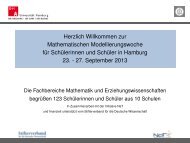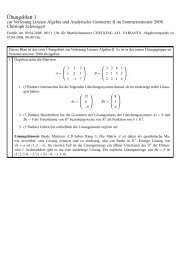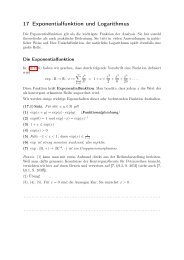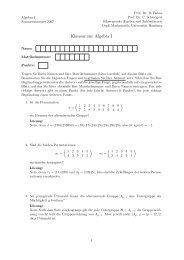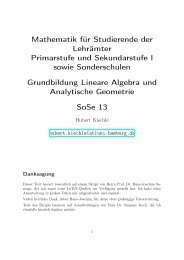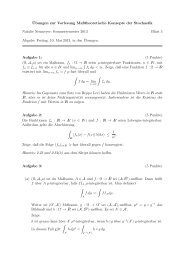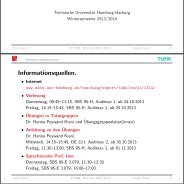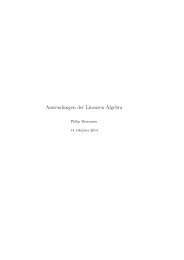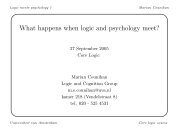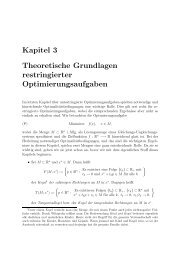pdf file
pdf file
pdf file
You also want an ePaper? Increase the reach of your titles
YUMPU automatically turns print PDFs into web optimized ePapers that Google loves.
1. We comment on the results in a language using bases. Let A be a Frobenius algebra. It<br />
is finite-dimensional and let (l i ) i=1,...N be a K-basis of A. Since the Frobenius form κ is<br />
non-degenerate, we can find another basis (r i ) i=1,...,N such that<br />
κ(l i , r i ) = δ ij .<br />
Such a pair of bases is called a pair (r i , l i ) of dual bases for the Frobenius form κ.<br />
2. Since (l i ) i=1,...N is a basis, we can write any x ∈ A as a linear combination, x = ∑ N<br />
i=1 x il i .<br />
Now<br />
N∑<br />
κ(x, r j ) = x i κ(l i , r j ) = x j<br />
and thus<br />
similarly,<br />
x =<br />
x =<br />
i=1<br />
N∑<br />
κ(x, r i )l i for all x ∈ A ; (6)<br />
i=1<br />
N∑<br />
κ(l i , x)r i for all x ∈ A . (7)<br />
i=1<br />
3. Conversely, given a pair of bases (r i , l i ) such that equation (6) holds for all x ∈ A, we find<br />
with x = l j that κ(l i , r i ) = δ ij and conclude that (7) holds for all x ∈ A.<br />
4. Consider for any dual bases the element<br />
C :=<br />
N∑<br />
r i ⊗ l i ∈ A ⊗ A .<br />
We claim that it is a Casimir element, i.e. xC = Cx for all x ∈ A. Indeed,<br />
implies<br />
Similarly, we find<br />
Cx =<br />
xC =<br />
i=1<br />
l i x =<br />
N∑<br />
κ(l i x, r i )l i<br />
i=1<br />
N∑<br />
r i ⊗ l i x =<br />
i=1<br />
N∑<br />
xr i ⊗ l i =<br />
i=1<br />
N∑<br />
κ(l i x, r j )r i ⊗ l i .<br />
i,j=1<br />
N∑<br />
κ(l i , xr j )r i ⊗ l i .<br />
i,j=1<br />
The invariance of the Frobenius form κ now implies xC = Cx.<br />
Remark 3.2.21.<br />
We can give explicitly a separability idempotent of a finite-dimensional semisimple Hopf algebra.<br />
1. Let λ ∈ H ∗ be a non-zero left integral and let Λ ∈ H be a right integral that λ(Λ) = 1,<br />
c.f. proposition 3.1.25. Then we have<br />
S(Λ (1) )〈λ, Λ (2) x〉 = S(Λ (1) )Λ (2) x (1) 〈λ, Λ (3) x (2) 〉 [λ cointegral]<br />
= x (1) 〈λ, Λx (2) 〉 [S antipode]<br />
= x〈λ, Λ〉 = x [Λ right integral, normalization]<br />
72




